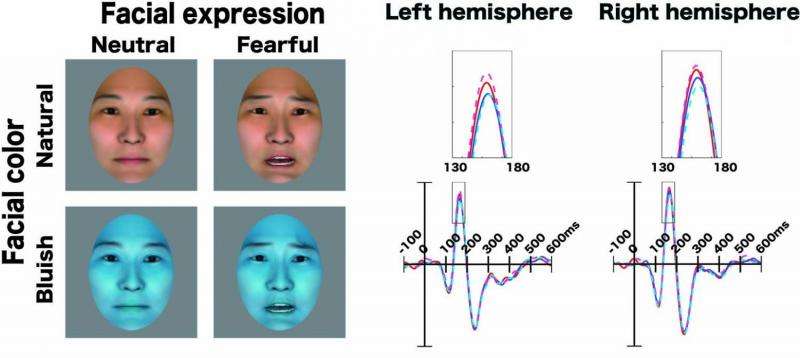Examples of the target face images and results of the ERPs in the subliminal condition are shown. Credit: Toyohashi University Of Technology.
Facial color is suggestive of emotional states, as in the phrases: "flushed with anger" and "pale with fear." Although some behavioral studies have investigated the effects of facial color on expression, there is limited neurophysiological evidence showing the effects of facial color on emotional expression perception.
Now, researchers at Electronics-Inspired Interdisciplinary Research Institute (EIIRIS) at Toyohashi Tech, found facial color affects early stage of subliminal processing of facial expression using ERPs, which provided the first neurophysiological evidence showing the effects of facial color on emotional expression perception. The researchers measured the brain activity from 15 participants during a facial emotion identification task of (1) neutral expressions of natural facial color, (2) fearful expressions of natural facial color, (3) neutral expressions of bluish facial color, and (4) fearful expressions of bluish facial color both in supraliminal and subliminal conditions.
"We have found that the bluish-colored faces increased the N170 latency effect of facial expressions compared to the natural-colored faces, indicating that the bluish color modulated the processing of fearful expressions in the subliminal condition" explains Associate Professor Tetsuto Minami.
The first author Kae Nakajima said "We have been interested in the subliminal effect of facial color since we found the supraliminal effect of facial color using ERPs and fMRI. "
As a result, the study has provided new electrophysiological evidence that facial color affects the subliminal processing of fearful expressions. The results showed that the effect of facial color on expression processing was significant in terms of the latency of the N170 only in the subliminal condition, which suggests that facial color has more of an effect on the early stages of expression processing compared to on the later processing stages.
This finding may contribute to promoting emotional interaction using avatars in virtual reality-world. The researchers would like to make their further studies to use natural change of facial color on facial expression perception in future.
More information: K. Nakajima et al. Effects of facial color on the subliminal processing of fearful faces, Neuroscience (2015). DOI: 10.1016/j.neuroscience.2015.09.059
Journal information: Neuroscience
Provided by Toyohashi University of Technology
























